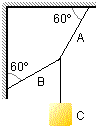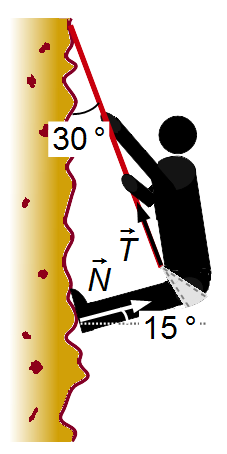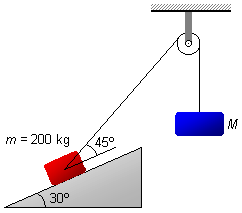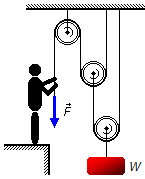Static Equilibrium
advertisement
Static Equilibrium
For the system in equilibrium shown in the figure, determine the tension forces on the strings A
and B knowing that body C has 100 N.

a) What is the magnitude of the tension in the rope?
b) What is the magnitude of the normal force exerted on the climber's feet?

A body with a mass of 200 kg is maintained in equilibrium on an inclined plane at 30° relative to the
horizontal by a cord passing through a fixed pulley and the other end supports a body with a mass
M. The rope makes with the inclined plane an angle of 45°. Determine:
a) The mass M;
b) The force exerted by the body on the plan.
a) The mass M;
b) The force exerted by the body on the plan.

A mass block m = 100 kg is suspended by the string system shown in the figure. Determine the
tension forces on all ropes.
Assume: \( \sin 15°=0.259 \), \( \cos 15°=0.966 \), \( \sin 45°=0.707 \), \( \cos 45°=0.707 \), \( \sin 60°=0.866 \), \( \cos 60°=0.5 \).
Assume: \( \sin 15°=0.259 \), \( \cos 15°=0.966 \), \( \sin 45°=0.707 \), \( \cos 45°=0.707 \), \( \sin 60°=0.866 \), \( \cos 60°=0.5 \).

A body with weight W is suspended by a system of pulleys and ropes. Assuming these elements are
lightweight and the pulleys and ropes have no friction. Determine:
a) The force that man must apply to the rope to keep the body in static equilibrium;
b) If the rope is pulled down 60 cm, how much does the body be lifted?
a) The force that man must apply to the rope to keep the body in static equilibrium;
b) If the rope is pulled down 60 cm, how much does the body be lifted?

Two identical spheres, A and B, are placed in a box. The line connecting the centers of
the two spheres makes an angle of 45° with the horizontal, and the reaction force exerted by the bottom
of the box on sphere B is 25 N. Determine the reaction force that the box exerts on the spheres at
the points of contact between the spheres and the box, and the force that sphere A exerts on
sphere B.

A body lies over an inclined plane of an angle α with the horizontal. To move upward it is required a force
parallel to the inclined plane whose minimum magnitude is F1 To prevent the body from
sliding down is required a force whose minimum magnitude is F2, also parallel to the slope.
If F1 = 2F2, calculate the coefficient of friction between the body and
the plane.
Three cylinders A, B, and C, with the horizontal axis and each weight W, are
in equilibrium on a system of two inclined planes, each with an angle of 30° relative to a plane, as
shown in the figure. Determine the magnitudes of reaction forces in each cylinder due to planes and
other cylinders.

advertisement

Fisicaexe - Physics Solved Problems by Elcio Brandani Mondadori is licensed under a Creative Commons Attribution-NonCommercial-ShareAlike 4.0 International License .